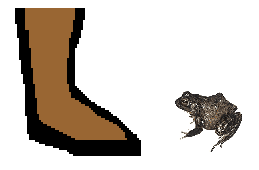Bullfrog

| Class: Amphibia:
Amphibians |
Diet: Insects |
| Order:
Anura: Frogs and Toads |
| Size: 9
- 20.5 cm (3 1/2 - 8 in) |
| Family: Ranidae:
True Frogs |
Conservation Status:
Non-threatened |
| Scientific Name:
Rana catesbeiana |
Habitat: lakes, ponds,
slow streams |
| Range:
Eastern and central USA; introduced in western areas and in Mexico, Cuba,
and Northern Italy |
 The
largest North American frog, the bullfrog makes a deep, vibrant call, amplified
by the internal vocal sac. Although an aquatic species, it also spends
time on land and is often seen at the water's edge. It is most active by
night, when it preys on insects, fish, smaller frogs and, occasionally,
small birds and snakes. Like all American ranid frogs, it is a good jumper
and can leap nine times its own length. In the north of their range,
bullfrogs breed from May to July, but farther south, the season is longer.
The female lays 10,000 to 20,000 eggs in water; they may float on the surface
or attach to vegetation. The eggs hatch in 5 or 6 days, but the tadpoles
take 2 to 5 years to transform into adults. The
largest North American frog, the bullfrog makes a deep, vibrant call, amplified
by the internal vocal sac. Although an aquatic species, it also spends
time on land and is often seen at the water's edge. It is most active by
night, when it preys on insects, fish, smaller frogs and, occasionally,
small birds and snakes. Like all American ranid frogs, it is a good jumper
and can leap nine times its own length. In the north of their range,
bullfrogs breed from May to July, but farther south, the season is longer.
The female lays 10,000 to 20,000 eggs in water; they may float on the surface
or attach to vegetation. The eggs hatch in 5 or 6 days, but the tadpoles
take 2 to 5 years to transform into adults.

  
|
